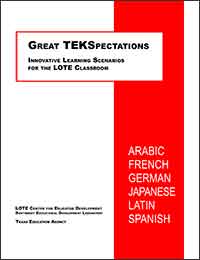Spanish Learning Scenario:
Famous Families
| Author: Ginger Cline & Ricci Hatten |
Students practice learned material related to physical and emotional characteristics and family relationships. In the course of the scenario, students become comfortable speaking about/describing themselves and others, and they learn to ask and respond to a variety of questions. They also increase their awareness of influential Hispanics throughout the world, both past and present.
ACTIVITY SET 1: Choosing a Famous Family
Students divide into groups of four or five. Each group is given a choice of Spanish-speaking countries (including the U.S.) from which to choose a family to research. They may choose either a modern or historical family. Students do their research using the Internet, magazines, books, and newspapers, using Spanish-language resources as much as possible. To reinforce and organize the data gathered in its research, each group mindmaps the information about their family and its characteristics.
ACTIVITY SET 2: Assuming New Identities
After each group has researched its chosen family, each student assumes the identity of a member of the family. The students prepare to describe themselves by writing brief sentences that tell their assumed name, age, date of birth, hair and eye color, stature, (tall or short), what they like and dislike to do, and what some of their personality traits are (serious or silly, lazy or hardworking, outgoing or shy, etc.). Students then use their written work and team up with a partner in their group to practice describing themselves orally.
ACTIVITY SET 3: Identifying Cultural Products
Next, the student groups investigate the cultural products of their family’s country. They identify or are given several cultural product categories (such as food, music, art, sports, etc.) and use their research sources to list as many items as they can under each category. They decide what products they will use to represent their country (Activity Set 4) and prepare a display of these products or facsimiles of them. They also come up with short statements about the cultural relevance of each of the products included in the display.
ACTIVITY SET 4: What Family Are We?
Using all of the information gathered in the preceding activities, students come to class prepared to play a “what family are we?” game. The student groups are encouraged to come to class dressed appropriately as their assumed character. Each group sets up a display of representative products from Activity Set 3. The names of all the families are posted around the room. The groups are then allowed to mingle about the class trying to determine who belongs to what family. The target language is used to pose questions such as:
• Where are you from?
• How old are you?
• When is your birthday?
• What are you like?
• What do you like to do?
• Who is he or she? (asked about a “relative”)
(They may not ask “What is your name?”!
Next, the class reassembles into “familial” groups. A show of hands is used to vote on the family the class believes each group represents. After tallying the results, the teacher calls out the name of a family and that group stands. The “eldest“ member introduces him or herself and each of the family members (e.g., this is my wife____, my daughter____ etc.). After the introductions, the rest of the family members take turns presenting the products assembled for their country and describing their cultural relevance. For example, a novice-level learner is able to say, “These are bananas. They grow easily in my country and are important to our economy.”
ACTIVITY SET 5: Writing About the Experience
As a final activity, students create a fictional journal entry, autobiographical poem, brief newspaper or “tabloid” article, obituary, or other written piece about themselves as the person they portrayed.
- Communication: Interpersonal, Interpretative, & Presentational Modes
- Cultures: Products & Perspectives
- Connections: Access to Information
- Comparisons: Influence of Language & Culture
- Computers with Internet access
- Spanish-language magazines
- Newspapers in English and Spanish
- ¿Qué Tal? magazine from Scholastic
- Props for representing cultural products
Communication: Students use the interpersonal mode to exchange information in pair work. The interpretive mode is used as students do research on their families and listen to one another’s presentations. Students use the presentational mode when they describe their families and cultural products to the class.
Cultures: Students identify the products of a Spanish-speaking country and describe their significance to the class.
Connections: Students use the language to access information via the Internet and other print media.
Comparisons: Students gain understanding of the influence that people of Hispanic heritage have had on American culture.
- Include a “What’s My Line” twist to the scenario. Instead of mingling together to gather information, the groups are seated in front of the class, one at a time. The rest of the class questions individuals of the group, but only about other members of their “family” (e.g., Who is she? What is he like? How old is she?). This enables students to practice questions and answers in the third person.
- For fun, have the students assume the identities of the Addams family, the Partridge family, Dr. Doolittle and his family, the Bush family, the Kennedy family, etc.
Magazines
- ¿Qué Tal?
This magazine is published specifically for students of Spanish; it profiles a famous Hispanic in each issue. - ¡Hola!
- People en Español
Webliography
NOTE: These Internet resources may have changed since publication or no longer be available. Active links should be carefully screened before recommending to students.
- http://www.sispain.org/spanish/index.html
This site has information on the Spanish Royal Family, available in both Spanish and English. - http://www.studying-in-spain.com
- http://coloquio.com/famosos/alpha.htm
- http://www.vistamagazine.com/
- http://www.atomicmuseum.com/tour/scientists.cfm
This site includes information on famous Hispanics in science.
Next Page: Folk Legends, Tales, and Fables: Creating and Reflecting Community


